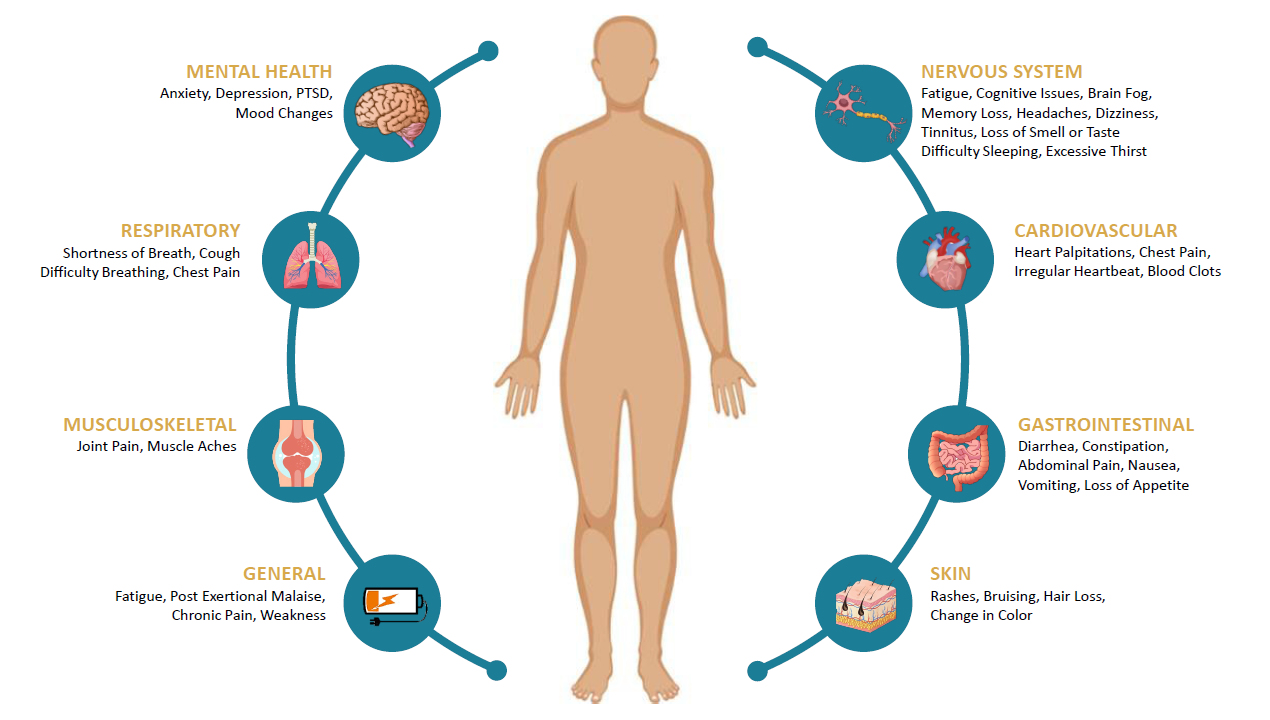What is Long COVID?
While most people with COVID-19 recover within 10-14 days, some individuals, even those with mild initial symptoms or asymptomatic cases, may experience lingering health issues for weeks, months or even years after their initial diagnosis. Long COVID, also known as post-COVID-19 conditions, long-haul COVID, chronic COVID, and post-acute sequelae of SARS-CoV-2 (PASC), is the term most commonly used to describe the persistence or development of symptoms and conditions beyond the acute phase of a COVID-19 infection.
People with Long COVID may experience health problems from different types and combinations of symptoms, including respiratory, neurological, cardiac and psychological problems. These symptoms vary widely from person to person and can be:
- Persistent, meaning they developed during the initial COVID-19 infection and never went away
- Recurrent, meaning they were present during the initial infection, resolved, and then returned
- New, meaning they were not present during the initial COVID-19 infection
Symptoms of Long COVID can range in severity from mild to debilitating and may significantly impact a person’s quality of life. Some of the most commonly reported symptoms include:

For accessible text from the infographic above, please click here.
While symptoms can be unpredictable and become worse after a period of improvement, it’s important to remember there is a light at the end of the tunnel and more resources than ever before to help navigate you through.
Frequently Asked Questions
If you're experiencing persistent symptoms after a COVID-19 infection or suspect you may have Long COVID, you should schedule an appointment with your primary care provider or a healthcare professional.
Prepare for your initial appointment by writing a brief summary of your experience with COVID-19 and ongoing health problems. Your summary should include as much of the following information as possible:
- The date your original COVID-19 symptoms began
- The date you received a positive COVID-19 test result
- When your Long COVID symptoms began
- A list of prior treatments and/or test results related to your symptoms
- How your symptoms affect your daily activities, family, work, school, etc.
- How often your symptoms occur
- A description of some of your best and worst days
It's also a good idea to make a list of questions ahead of time and prioritize them in order of importance to ensure you talk about the most important items first.
While the exact cause of Long COVID remains unclear, experts have proposed several theories, such as:
- Remnants of COVID-19 may remain in the body after initial recovery and continue to stimulate an immune response
- Overactive immune cells may release high levels of inflammatory substances that can injure organs and tissues
- An autoimmune response is triggered by the COVID-19 virus, causing the immune system to attack the body's own healthy organs and tissues
- COVID-19 may cause a previous virus, which was in an inactive or dormant state, to reactivate
Researchers are still working to understand why some people develop Long COVID and others don’t. Some studies have shown you might be more at risk for developing Long COVID if you:
-
Had severe COVID-19, especially if you were hospitalized or required intensive care
-
Had an underlying medical condition prior to developing COVID-19, such as diabetes, asthma, obesity, or an autoimmune disorder
-
Had multisystem inflammatory disorder (MIS-C) during or after having COVID-19
-
Haven't been vaccinated against COVID-19
No laboratory test currently exists to diagnose Long COVID. Instead, a diagnosis is largely based on the patient's history of COVID-19 and by ruling out other possible causes for their lingering symptoms. The process of elimination will vary from person to person and may include the following:
- Bloodwork
- Chest X-ray
- CT scan
- Pulmonary (lung) function tests
- Electrocardiogram (EKG/ECG)
- Echocardiogram (Echo)
The best way to prevent Long COVID is to protect yourself from becoming infected with COVID-19. To reduce your risk of infection:
-
Stay up to date on COVID-19 vaccines
-
Avoid close contact with people who have a confirmed or suspected illness
-
Wash your hands regularly
-
Wear a multilayered, well-fitted mask, such as a KN95 or N95
-
avoiding crowded, poorly ventilated indoor spaces, especially when illness levels are high
-
Seek immediate treatment if you test positive or suspect you have COVID-19. Recent evidence from observational studies shows taking antiviral drugs, such as Paxlovid, within 5 days of developing COVID-19 symptoms may lower your risk of developing Long COVID symptoms.
The duration of symptoms varies widely from person to person. Some people experience symptoms for several weeks or months, while others may have symptoms that persist for years. For those with multiple symptoms, some may resolve while others persist. Research shows that for most people, symptoms will gradually improve over time.
